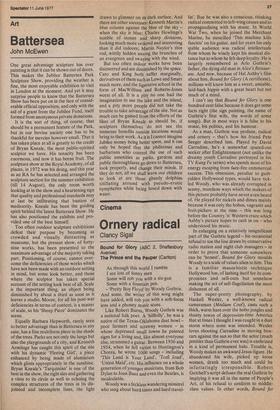Art
Battersea
John McEwen
One great advantage sculpture has over painting is that it can be shown out of doors. This makes the Jubilee Battersea Park Sculpture Show, providing the weather is fine, the most enjoyable exhibition to visit in London at the moment. And yet it may surprise people to know that the Battersea Show has been put on in the face of considerable official opposition, and only with the aid of a grant from the Jubilee Fund, itself formed from anonymous private donations. It is the sort of thing, of course, that should be a permanent feature of the Park, but in our bovine society one has to be thankful for mercies however small. That it has taken place at all is greatly to the credit of Bryan Kneale, the most public-spirited sculptor we have. His tenacity has been enormous, and now it has borne fruit. The sculpture show at the Royal Academy, of all places, in 1972 was his doing, and this year as an RA he has selected and arranged the sculpture section for the summer exhibition (till 14 August), the only room worth looking at in the show and a heartening sign that quality and professional standards may at last be infiltrating that bastion of mediocrity. Kneale has been the guiding spirit behind the latest Battersea Show. He has also positioned the exhibits and provided one of the best himself.
Too often outdoor sculpture exhibitions defeat their purpose by becoming as crowded and visually distracting as museums, but the present show, of fortynine works, has been presented to the maximum advantage of the majority taking part. Positioning, of course, cannot overcome the deficiencies of those works which have not been made with an outdoor setting in mind, but some look better, and those where the sculptor has taken special account of the setting look best of all. Scale is the important thing, an object being diminished by about a third as soon as it leaves a studio. Moore, for all his post-war deficiencies in terms of content, is a master of scale, so his 'Sheep Piece' dominates the scene.
Equally Barbara Hepworth, rarely seen to better advantage than in Battersea in any case, has a fine multiform piece in the shade of the trees. Parks are not only the lungs but also the playgrounds of a city, and Kenneth Armitage has caught this spirit of the site with his dynamic 'Fleeing Girl', a piece enhanced by being made of aluminium which glints appropriately in the sunshine. Bryan Kneale's `Tarquinian' is one of the best in the show, the right size and gathering a vista to its circle as well as echoing the complex structures of the trees in its disjointed and incomplete lines, the light "drawn to glimmer on its dark surface. And there are other successes: Kenneth Martin's blue column against the blue of the sky — when the sky is blue; Charles Hewlings's tumble of stones and sharp _divisions, looking much more ordered and interesting than it did indoors; Martin Naylor's thin rod, wittily hidden among the branches of an evergreen and swaying with the wind. But too often indoor works have been disinterred and are diminished by the space. Caro and King both suffer marginally, derivatives of them such as Lowe and Smart much more, and the figurative school in the form of MacWilliam and Roberts-Jones worst of all. It is a pity no one had the imagination to use the lake and the island, and a pity more people did not take the trouble to take advantage of the site. Not as much can be gained from the efforts of the likes of Bryan Kneale as should be, if sculptors themselves do not see the immense benefits outside locations would bring to their work. As it is I cannot imagine Jubilee money being better spent, and it can only be hoped that the philistines and barbarians who control the use of such public amenities as parks, gardens and public thoroughfares go down to Battersea, look properly, and change their minds. If they do not, all we shall leave our children to look at are those ghastly dolphins titillating around with pseudo-erotic nymphettes while being hosed down with water.


































 Previous page
Previous page